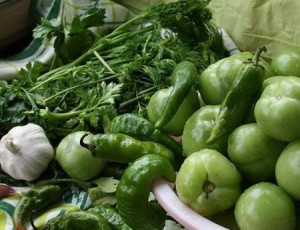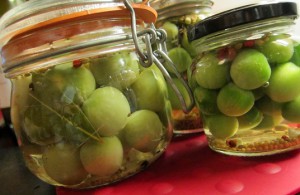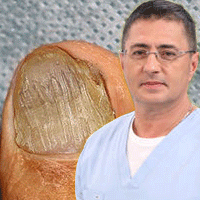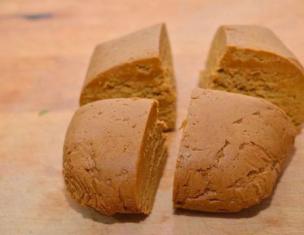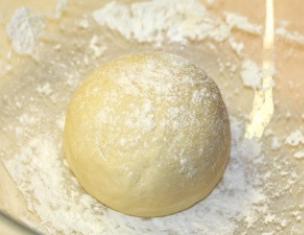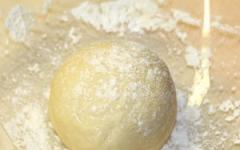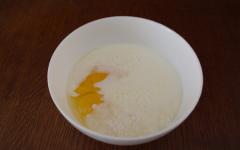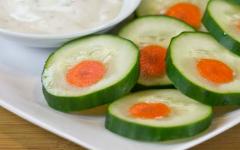Tomatoes should stand 10-14 days until salted. They will be salty like a barrel. Yummy! I advise everyone to cook, do not be disappointed!
Ingredients:
Tomatoes ripe 4-5 kg, depending on size.
Dill greens.
Garlic head.
Hot red pepper 2 pieces.
Salt 500-700 grams.
Water 5 liters.
Cooking:
Wash the tomatoes well. Rinse the dill. Chop the garlic (1 head) plates. Cut a couple of pieces of red hot pepper in half, carefully removing seeds from it.
At the bottom of the bucket 10-12 liters put dill, a little cloves of garlic and red hot peppers. Then put ripe tomatoes on top, alternating them with dill and garlic.
So put in a bucket about 4-5 kg of tomatoes, depending on the size. To the very top, do not report about 10 cm. From above close the tomatoes with dill.
Then pour 500-700 grams of salt into 5-liter dishes. Pour her cold water from the tap and stir well.
Then pour this salt water in a bucket of tomatoes. Put a plate on top, put a load of 3 on it liter jar with water about.
So tomatoes should stand 10-14 days, until they become salty. They will be salty like a barrel.
Yummy! Enjoy your meal!
Tomatoes, salted in a bucket or barrel for the winter, were not so long ago distributed everywhere in the villages. These are the most tasty and useful tomatoes - they are skachivayutsya due to the formed lactic acid, have a slightly harsh sour-sweet taste. Such tomatoes are a great snack for boiled potatoes, kebabs. They have one disadvantage - they “puff” too quickly, i.e. lose elasticity, fill with gas and burst, therefore, opening a bucket or a can. These tomatoes should be eaten as soon as possible - preferably on the first day.
When the tomatoes were salted in barrels, they simply went down to the cellar or cellar, where they were kept cool, gathered tomatoes into the cup, and the others again covered them with gauze and a wooden circle - they were always, as if just cooked. In a city apartment for making salted tomatoes for the winter in a bucket, I recommend taking small plastic buckets for pickling.
For salting, we make strong, slightly unripe tomatoes, tomatoes, dill, garlic, peas, bay leaves, horseradish leaves and currants, salt and water.
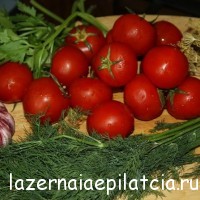
First make a pickle. Boil water, take salt, depending on the size of the tomatoes - 1-2 tablespoons. If the tomatoes are large, then there will be more brine between them, which means more salt is needed. Immediately add bay leaf and pepper to the water. Boil the brine and put to cool in a cold place - on the balcony, for example.
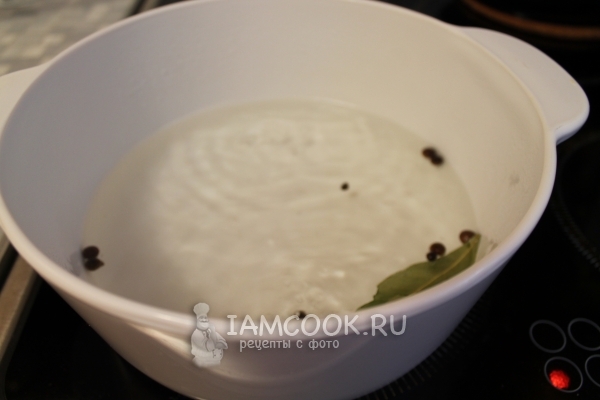
We will prepare plastic buckets - we will well wash them and dry them, we will wash tomatoes and greens. Also let the drain water.
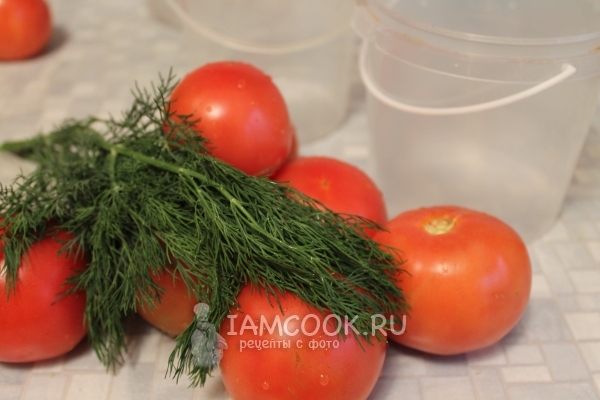
In the bucket we put the chopped leaf of horseradish on the bottom, currant leaves (if you are salting in the fall, at a later time, you can take dried greens or do what you have), dill greens, sliced garlic.
![]()
Then we pierce the tomatoes with a toothpick at the base of the stem - this will allow the tomatoes to salt out more evenly, they have a very dense skin. In the free space we fill greens and chives - they will also be tasty.
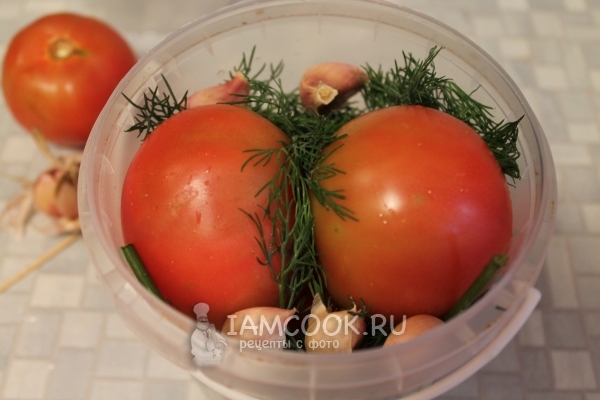
Fill with slightly warm or completely cooled brine.
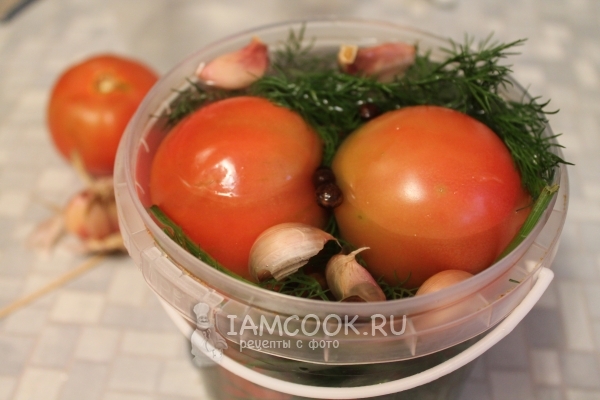
We close the tomatoes with lids, we can put oppression for the first 1-2 days. When the fermentation process takes place - 3-4 days (this will be noticeable due to the clouding of the brine and the absence of bubbles), bring the salted tomatoes in the bucket for the winter to a cold place - to a permanent storage place.
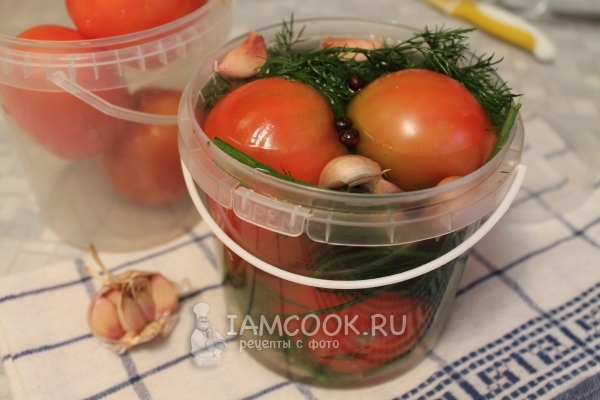
After a week and a half you can try (you can try before, salted tomatoes are also very tasty!).
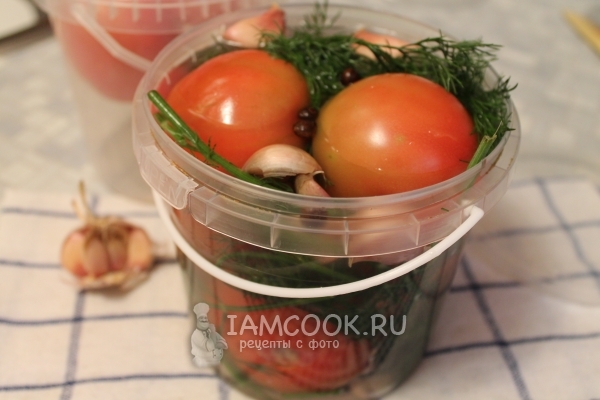
Pickling tomatoes in a cold way is very popular in modern, busy affairs hostesses. Tomato is perhaps one of the few vegetables that almost everyone loves. They can be eaten both fresh and marinated, pickled, fried, boiled, baked, and you can also make homemade tomato juice, ketchup, adjika and pasta.
So that in the winter you can enjoy the healthy fruits, they are preserved in various ways. Most often used hot and cold way salting tomatoes. Unlike hot pickling, the cold way of pickling tomatoes does not take much time, effort, and after a short time you get an appetizing, tasty and healthy snack.
Preparatory stage
The recipe for salting tomatoes in a cold way is quite simple., but any process, including salting a tomato, requires preliminary preparations. In order for your home canned foods to be tasty and, most importantly, useful, you need to select only fresh, not overripe tomatoes. It is better if they are elastic, without cracks and diseases. Do not choose unnecessarily large fruits, since in consequence they will be very uncomfortable to eat. Tear off all the stalks and wash them thoroughly. Then spread out on a clean paper towel until dry.
Carefully wash the container, in which you will produce pickling tomatoes. This can be either a three-liter jar, or any barrel, tub or plastic bucket with a lid and dry it. For salting in the cold way, you can take a little deformed cans, with small chips on the neck, because you will not need to roll them up, but simply close them with plastic covers. It is also recommended to pour boiling water over the jars to get rid of possible bacteria.
The recipe for simple salting tomatoes in a cold way
Based on 3 three-liter banks you must take:
- about 6 kg of tomato;
- half a glass of regular table salt;
- half a glass of granulated sugar;
- about 3.5 liters of clean settled or spring water;
- 1 glass of table vinegar 9%;
- two large heads of garlic;
- a bunch of dill (you can take already dried up and even umbrellas);
- 6 pieces of bay leaves;
- about 30 black peppercorns;
- a couple of celery branches;
- you can add other spices (currant and grape leaves, cloves).
Cooking process
We take banks and put in each of them a pair of bay leaves and a third of pea-scented allspice, three chopped garlic cloves, celery and dill. Before salting, we pierce the tomatoes several times with a toothpick. This is done so that in the future the juice does not splash out of the tomato in different directions when eaten. Next, carefully put the tomatoes in jars as tightly as possible, but without pressing them. Top add more garlic, celery and vinegar. Then you need to make cold pickle. Pour clean, defended or bottled water into the pan and add salt, granulated sugar, vinegar.
All ingredients are thoroughly stirred until dissolved. To taste the pickle will be sweet-sour-salty. Total should be in moderation. Then leave it for a while and filter through gauze. Fill it in jars and cover with plastic film or lid. This amount of brine should be enough for the whole portion. To cover tightly dressed on the banks and did not slip, they must be held in boiling water for several minutes. It will also disinfect and make them resilient. Next, send the banks in a cold place. After a few weeks, you can taste your own pickled tomatoes in a cold way.
Cold pickled tomatoes with mustard
With this type of pickling, the process of making fruits and containers is the same as in the previous recipe. But the difference lies in the composition of the brine. In addition to salt, sugar, vinegar, dry mustard powder is added to the hot water at the rate of 15 grams for every 1 liter of water. Next, give the brine to cool and pour them tomatoes. Preservation put for a few days in the cold, after which the tomatoes are ready.
Cold-pickled green tomatoes
It is not always possible to salt already ripe, red tomatoes. There are cases when you have a lot of green fruit on your hands. There are very delicious recipe salting just green tomato. It is necessary to take:
- 1kg of green fruit;
- 1 liter of clean water;
- 2st. spoons of dill seeds (you can pick them yourself in the garden or buy them in a seed shop);
- clean, fresh leaves of black currant;
- 4-5 cherry leaves each;
- 1 tbsp. spoon of sugar;
- 2 tbsp. spoons of salt;
- sweet pea.
Brine do the same way and pour into banks. Corked cans should be put in a dark place for a week and then sent to a cold basement or refrigerator.
Salting tomatoes in a dry way
Unlike previous recipes, this method is interesting in that it does not use brine and water. The disadvantage of dry salting is that the fruits lose their shape and look less attractive. But they retain the maximum amount of useful vitamin, so necessary for the body during the period of winter and spring avitaminosis. So, in the pre-scalded boiling water container impose washed horseradish leaves. Top lay out a layer of tomato, currant leaves, cherry leaves, dill and sprinkle with salt. From above we place again the leaves of horseradish and from above lay the oppression. In this form, salting is left for a day in a warm place, and then cleaned in the cellar or refrigerator.
Use salted tomatoes in dishes
Salty tomatoes will replace many seasonings in dishes. For example, tomatoes grated through a sieve can be added to borscht and various red soups. They can replace ketchup, pasta, dressing for second courses. The sharpness of the tomatoes attached savory taste sauces Eco-friendly brine can be eaten. A good addition to tomatoes will be to the fried potatoes and meat dishes.
Health Benefits of Salted Tomatoes
 Salty tomatoes contain almost as many vitamins and mineral elements as fresh fruit. They contain magnesium, boron, iodine, sodium, calcium, iron and copper. Due to the low calorie content (only 13Kk per 100 grams), they can be used by weight-lifting people. Also regular consumption of salted tomatoes significantly reduces the risk of diseases of the pancreas, cardiovascular system, diseases of the cervix and prostate gland.
Salty tomatoes contain almost as many vitamins and mineral elements as fresh fruit. They contain magnesium, boron, iodine, sodium, calcium, iron and copper. Due to the low calorie content (only 13Kk per 100 grams), they can be used by weight-lifting people. Also regular consumption of salted tomatoes significantly reduces the risk of diseases of the pancreas, cardiovascular system, diseases of the cervix and prostate gland.
Scientists have traced the pattern in which people who eat tomatoes in their raw or cooked form are less likely to suffer from cancer. This is due to the fact that the substances in their composition strengthen the DNA and prevent cell mutations. Ordinary pickles can also treat the nervous system, since this vegetable includes a powerful antidepressant, serotonin.
The most useful are those tomatoes that were prepared without the use of vinegar, although it speeds up the salting process, but the benefits of them are reduced. Tomato brine has long been used as an effective folk remedy for hangovers. So that you have at hand the most powerful cladets of health for literally ridiculous cost. But besides the undeniable advantages of salted tomatoes, there is some harm.
Harm that can make health pickles
Tomatoes are mostly red in color, so they can cause allergies in those people who are absolutely not recommended to eat vegetables and fruits of scarlet color. It is also necessary to use caution in pickles for people with diseased kidneys, weak cardiovascular system and gallstone disease, as they include a large number of salt. And salt retains water in the body, which overwhelms weak kidneys. For the same reason, you should limit the dishes with salted tomatoes to people who are overweight.
Foreword
The end of summer and the beginning of autumn is the time of harvest. Many seek to make seaming for the winter, and in this article we will pay attention to tomatoes, we will share recipes for how to pickle tomatoes.
1 Salted tomatoes and their preservation - general information
At all times, canned vegetables were in great demand. A tomato is probably a gardener who everyone likes. It should be noted that skillful housewives try to use not only red ripe tomato, but also unripe. In addition, the unripe fruit turns out quite tasty, if you use a proven recipe for how to pickle green tomatoes. The discovery for gourmets will also be a tomato in its own juice, we will also touch on this culinary masterpiece.
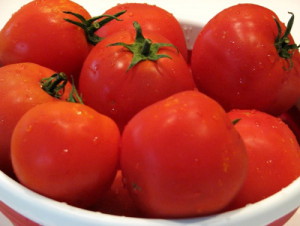

Currently, there is a wide variety of techniques, so each housewife can cook for their household exactly what they like. So, let's get acquainted with the most interesting and original recipes, we will separately consider the technologies by which our grandmothers and even great-grandmothers rolled up pickled tomatoes.
There are two basic methods for salting tomatoes in the winter. Both of them will help not only to create an unusual taste, but also to preserve the appearance of the tomato and its shape. It is a cold and hot technology, each of which has its own characteristics, as well as a wide variety and number of recipes. Guessing what the difference is is simple.
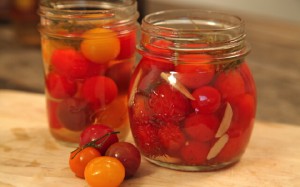
In the old days, tomatoes and cucumbers were seasoned in barrels. Today, this container has been replaced by the usual bucket. At the same time, such salty tomatoes taste no worse than before. We will need 4–5 kg of ripe tomatoes, it is desirable to select the same size so that fermentation is carried out evenly, dill, garlic head, red hot pepper - 2 pieces, salt 500–700 g, water.
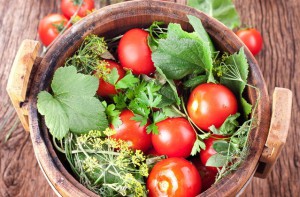
So, the recipe for salting is quite simple, but requires precise and careful compliance with the instructions. First you need to prepare all the ingredients, that is, wash and dry the tomatoes, dill, garlic and pepper. Peel the garlic and cut into small plates. Pepper is cut into equal halves and cleaned of seeds. At the bottom of the bucket 10–12 l carefully lay out all the ingredients in a certain sequence. First, fennel greens, then garlic and red pepper, so the tomato cushion is ready. The next layer is the tomatoes themselves, and then again a strip of greens, and again our vegetables. Such a “cake” is laid until a bucket is filled.
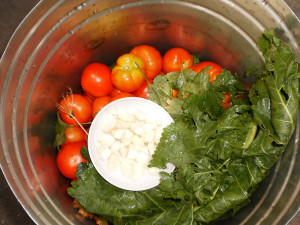
But remember, 10 cm to the top should not be filled with anything, and the last layer should be green.
Everyone knows that sometimes tomatoes just do not have time to ripen in bunches, and in order not to disappear the vegetable, the mistresses have mastered a couple of simple conservation techniques. Today, there are quite a number of ways to cook green pickled tomatoes, recipes are often fairly simple and straightforward, and we will try to choose the most affordable ones.
The first method of seaming, despite its simplicity, makes even unripe tomatoes very tasty. So, for this recipe for the preservation of tomatoes, we need 1 kg of green fruit, celery, or rather its leaves (200 g), 50 g of garlic, 1 hot red pepper. To prepare the brine will need a liter of water, 1 tbsp. l salt, fennel inflorescences with seeds (60 g), 3 lavrushki, 8 peas. And now we will plunge into the culinary part.
We start with the preparation of brine. All ingredients are thoroughly mixed and brought to a boil. At this time, we start stuffing green tomatoes. All fruits must be cut and in neat movements inside the tomato lay a plate of garlic and pepper circles. As a result, you should get a tomato, which in its appearance resembles a hamburger, but not completely cut. In such a tomato can be laid on several plates of garlic and pepper rings, so that the taste is more saturated and spicy.
Now tomatoes are stacked in a pan in layers, as a rule, tomatoes alternate with a strip of spinach leaves. For those who love everything spicy, on the sides you can also put a couple of hot peppercorns. The final must be a layer of greenery, after which the entire contents of the pan is poured with brine and covered with a lid, on which you can also put pressure, to speed up the fermentation process. It is worth noting that the tomatoes in this recipe can also be closed under the lid.
The second way to preserve an unripe fruit is to salting it in a barrel. To do this, prepare 10 kg (for a barrel in 8 l), 200 g of sugar, 200 g of dill greens, 20 g of bitter pepper, you can red hot, and 20 g of currant leaves or cherries. Consider that the tomatoes in the process of preservation and salting will remain as dense and tough. And in order to make them a little softer, it is recommended to boil them with boiling water before salting, or lower them into boiled water for 1–2 minutes, this will be enough to soften them.
So, the tomatoes are stacked in layers in a barrel. First, a pillow of greens, then tomatoes, so alternate to the top, until only 10 cm is left free. After the barrel is filled with tomatoes, all this must be carefully poured with the prepared brine and closed with a lid with a yoke. The barrel retracts in a dark and cold place to expect winter. To evenly distribute the taste of all the tomatoes, experts recommend shaking the barrel periodically.
And a little about the secrets ...
Have you ever experienced unbearable joint pain? And you know firsthand what it is:
- inability to move easily and comfortably;
- discomfort when climbing and descending stairs;
- unpleasant crunch, clicking not at will;
- pain during or after exercise;
- inflammation of the joints and swelling;
- unreasonable and sometimes intolerable aching pain in the joints ...
And now answer the question: does it suit you? Is it possible to endure such pain? And how much money have you already “leaked” to ineffective treatment? That's right - it's time to stop this! Do you agree? That is why we decided to publish an exclusive interview with Professor Dikul, in which he revealed the secrets of getting rid of joint pain, arthritis and arthrosis.
How to salt tomatoes in a cold way: recipes, tips, photos and videos
Salted tomatoes - one of the popular blanks for the winter. They are a great substitute. tomato paste, ketchup and tomato dressing in the preparation of various dishes.
Salted tomatoes can be served as an independent snack.
Hot salting requires a lot of time and skill: the banks must be thoroughly sterilized and rolled up, the brine may become cloudy, and the banks may explode.
The perfect option quick salting serves cold seaming tomatoes.
Benefits of cold pickling
- Pickles are much tastier than with seaming in other ways;
- Less loss of vitamins from tomatoes (due to the lack of heat treatment);
- Does not require much time.
- Light salting technology;
- No need to boil water for brine;
- Tomatoes can be consumed within three weeks after salting;
- Blanks can be made in any containers (including in sterilized jars);
The disadvantage of this method is that all containers with pickles must be stored in a cool place, otherwise the tomatoes will spoil.
Preparation for pickling
- Tomatoes must be of the same degree of ripeness (green, pink and red tomatoes should not be taken for one container);
- Fruits should not be rotting and mildew;
- Tomatoes should not be beaten and soft;
- You should not take tomatoes for salting, which are damaged - cuts and punctures.
All tomatoes need to be separated from the stem, wash well, dry with a soft towel and make a neat puncture next to the stem (so that the skin of tomatoes does not crack when they are stored in brine).
First, pick tomatoes about the same size. When the same tomatoes run out, you can pickle tomatoes of different sizes in the same container.
- If we use the cans, rinse them thoroughly (preferably with detergent) and to sterilize. To do this, hold the glass container over water vapor for 3-5 minutes, then set to cool, covering them with a clean towel;
- Containers of other materials should be washed (using detergents);
- A container used for salting may be defective, because we will not need to roll it up.
- Iodized. Rich in iodine, sometimes gives a faint bitterness;
- Sea It is rich in various microelements, but if magnesium is removed from it, then it is ordinary table salt;
- Black Rich in potassium, beneficial to the human body;
- Hypanoatric. Salt for hypertensive patients, because it uses salts of potassium and magnesium. This prevents fluid retention and high blood pressure.
Note! For getting tasty salty tomatoes, it is recommended to use coarse ground salt only.
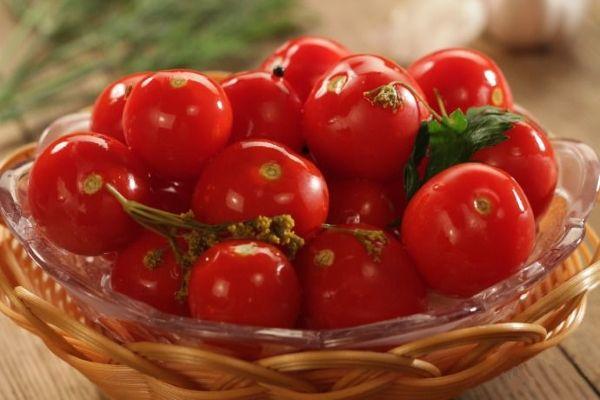
Recipes
1. Salting tomatoes in a cold way
Step 1. Prepare a container for salting.
Step 2. Prepare the tomatoes. Be sure to make a puncture!
Step 3. At the bottom of the tank we place the leaves of the plants so that they completely hide it. Next, lay out the umbrellas dill.
Step 4. Fill the container with tomatoes. Fold the tomatoes tightly to each other. It is necessary to ensure that the tomatoes are not crushed and not damaged. It is advisable to put the tomatoes punctured up. Laying out layers, you need to close them with horseradish leaves and add chopped garlic cloves. From above we leave about 5-7 cm of free space.
Step 5. Add salt, sugar and vinegar to the container. Fill the tomatoes with boiled cold water.
2. Cold salting tomatoes with mustard
Step 2. We process tomatoes. Remove the stem, wash the tomatoes under running water and make a puncture next to the place from the stem.
Step 4. Layering the tomatoes. Put the spices between the layers. We reserve about 2–5 centimeters of free space.
Step 5. Cooking brine. In water (2 liters) add salt, sugar and the remaining spices. Fill the resulting brine in a container with tomatoes. It is not necessary to prepare the pickle separately. You can simply pour salt, sugar, spices in the container and pour it with cold boiled water.
Step 6. Making a mustard cork to prevent rotting and mold on the tomatoes. Fold gauze (bandage) 3 times and cover the surface of tomatoes stacked in a container. Leave the edges of the gauze in double or triple the size of the neck of the container. Fall asleep mustard powder or mustard seeds on gauze so that all tomatoes are closed. Top mustard cover dangling edges. Close the container lid.
3. Cold salting of green tomatoes
Step 1. Prepare the container.
Step 2. We process the tomatoes (washing, peeling of the stalks). We make a puncture near the hole for the stem.
Step 3. At the bottom of the container lay out the leaves of horseradish (currants, cherries).
Step 4. Layers lay out the green tomatoes, alternating them with spices.
Step 5. Cooking brine. In 2 liters of boiled water dissolve salt. You can add a couple of pieces of bay leaf.
Step 6. Fill the brine in a container with tomatoes. Salt sediment is not poured!
Step 7. Fill the neck of the container with mustard powder. Close the container should be scalded with boiled water lids.
4. Salting tomatoes dry cold
- Tomatoes - 2 kg;
- Salt - standard kilogram pack;
- Dill - 1 umbrella and a handful of dried dill;
- Green leaves of horseradish, cherry and currant.
Step 1. Prepare the container.
Step 2. We process the tomatoes: mine, separate the stalk, pierce with a fork.
Step 3. Covering the bottom of the tub with leaves and dill.
Step 4. Putting tomatoes. Each layer is generously seasoned with salt. Salt consumption depends on taste preferences.
Step 5. Put the leaves of currants, cherries and horseradish. They should cover the entire last layer of tomatoes.
Step 6. Close the leaves with a wooden circle and set the load.
Step 7. Insist the tomatoes in a warm place for a day.
Important! Cold pickling is produced in any container, but if glass jars are used to store tomatoes, they are still better sterilized.
The recipe for cold pickling is basically the same, only the additional ingredients differ. The taste of salted tomatoes depends only on your imagination.
Ingredients that add to pickling:
You may also be interested to know why cucumbers grow crochet and how to avoid it.
Storage of blanks
In winter, perfect storage on the balcony. If you keep tomatoes in a warm room, they quickly perekisnut and become tasteless.
You can store salted tomatoes, prepared in a cold way, all winter. And to use - after 3-4 weeks after salting.
Cold salting tomatoes saves time by preparing pickles rich in vitamins and minerals.
How to salt tomatoes in a cold way in a wooden barrel, see the video:
More information


